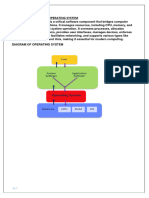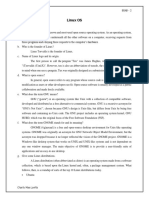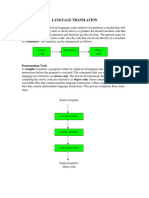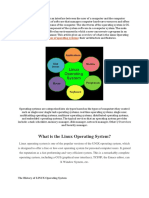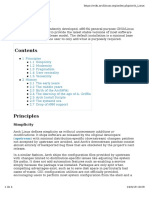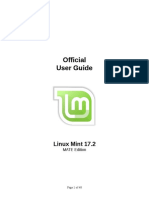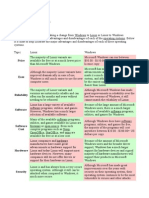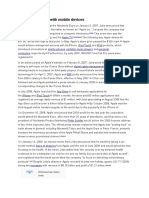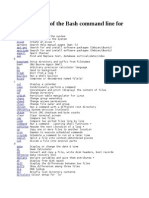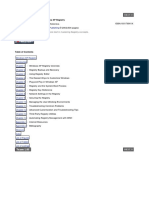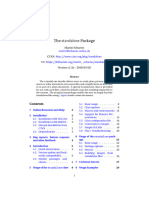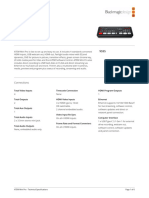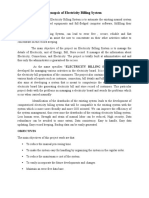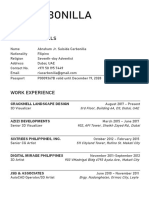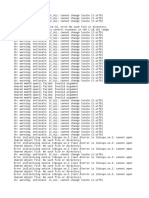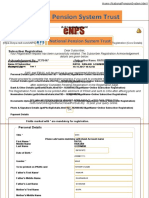Introduction to UNIX and Linux: Lecture 1 http://www.doc.ic.ac.uk/~wjk/UnixIntro/Lecture...
Introduction to UNIX:
Lecture One
1.1 Objectives
This lecture covers:
The concept of an operating system.
The internal architecture of an operating system.
The evolution of the UNIX operating system into two
broad schools (BSD and SYSV) and the development of
Linux, a popular open source operating system.
The architecture of the Linux operating system in more
detail.
How to log into (and out of) UNIX and change your
password.
The general format of UNIX commands.
1.2 What is an Operating System?
An operating system (OS) is a resource manager. It takes
the form of a set of software routines that allow users and
application programs to access system resources (e.g. the
CPU, memory, disks, modems, printers network cards etc.)
in a safe, efficient and abstract way.
For example, an OS ensures safe access to a printer by
allowing only one application program to send data directly
to the printer at any one time. An OS encourages efficient
use of the CPU by suspending programs that are waiting for
I/O operations to complete to make way for programs that
can use the CPU more productively. An OS also provides
convenient abstractions (such as files rather than disk
1 of 10 24/10/2019, 12:18 PM
�Introduction to UNIX and Linux: Lecture 1 http://www.doc.ic.ac.uk/~wjk/UnixIntro/Lecture...
locations) which isolate application programmers and users
from the details of the underlying hardware.
Fig. 1.1: General operating system architecture
Fig. 1.1 presents the architecture of a typical operating
system and shows how an OS succeeds in presenting users
and application programs with a uniform interface without
regard to the details of the underlying hardware. We see
that:
The operating system kernel is in direct control of the
underlying hardware. The kernel provides low-level
device, memory and processor management functions
(e.g. dealing with interrupts from hardware devices,
sharing the processor among multiple programs,
allocating memory for programs etc.)
Basic hardware-independent kernel services are
exposed to higher-level programs through a library of
system calls (e.g. services to create a file, begin
execution of a program, or open a logical network
connection to another computer).
2 of 10 24/10/2019, 12:18 PM
�Introduction to UNIX and Linux: Lecture 1 http://www.doc.ic.ac.uk/~wjk/UnixIntro/Lecture...
Application programs (e.g. word processors,
spreadsheets) and system utility programs (simple
but useful application programs that come with the
operating system, e.g. programs which find text inside
a group of files) make use of system calls. Applications
and system utilities are launched using a shell (a
textual command line interface) or a graphical user
interface that provides direct user interaction.
Operating systems (and different flavours of the same
operating system) can be distinguished from one another by
the system calls, system utilities and user interface they
provide, as well as by the resource scheduling policies
implemented by the kernel.
1.3 A Brief History of UNIX
UNIX has been a popular OS for more than two decades
because of its multi-user, multi-tasking environment,
stability, portability and powerful networking capabilities.
What follows here is a simplified history of how UNIX has
developed (to get an idea for how complicated things really
are, see the web site http://www.levenez.com/unix/).
3 of 10 24/10/2019, 12:18 PM
�Introduction to UNIX and Linux: Lecture 1 http://www.doc.ic.ac.uk/~wjk/UnixIntro/Lecture...
Fig. 1.2: Simplified UNIX FamilyTree
In the late 1960s, researchers from General Electric, MIT
and Bell Labs launched a joint project to develop an
ambitious multi-user, multi-tasking OS for mainframe
computers known as MULTICS (Multiplexed Information
and Computing System). MULTICS failed (for some
MULTICS enthusiasts "failed" is perhaps too strong a word
to use here), but it did inspire Ken Thompson, who was a
researcher at Bell Labs, to have a go at writing a simpler
operating system himself. He wrote a simpler version of
MULTICS on a PDP7 in assembler and called his attempt
UNICS (Uniplexed Information and Computing System).
Because memory and CPU power were at a premium in
those days, UNICS (eventually shortened to UNIX) used
4 of 10 24/10/2019, 12:18 PM
�Introduction to UNIX and Linux: Lecture 1 http://www.doc.ic.ac.uk/~wjk/UnixIntro/Lecture...
short commands to minimize the space needed to store
them and the time needed to decode them - hence the
tradition of short UNIX commands we use today, e.g. ls, cp,
rm, mv etc.
Ken Thompson then teamed up with Dennis Ritchie, the
author of the first C compiler in 1973. They rewrote the
UNIX kernel in C - this was a big step forwards in terms of
the system's portability - and released the Fifth Edition of
UNIX to universities in 1974. The Seventh Edition, released
in 1978, marked a split in UNIX development into two main
branches: SYSV (System 5) and BSD (Berkeley Software
Distribution). BSD arose from the University of California at
Berkeley where Ken Thompson spent a sabbatical year. Its
development was continued by students at Berkeley and
other research institutions. SYSV was developed by AT&T
and other commercial companies. UNIX flavours based on
SYSV have traditionally been more conservative, but better
supported than BSD-based flavours.
The latest incarnations of SYSV (SVR4 or System 5 Release
4) and BSD Unix are actually very similar. Some minor
differences are to be found in file system structure, system
utility names and options and system call libraries as shown
in Fig 1.3.
Feature Typical SYSV Typical BSD
kernel name /unix /vmunix
boot init /etc/rc.d directories /etc/rc.* files
mounted FS /etc/mnttab /etc/mtab
default shell sh, ksh csh, tcsh
FS block size 512 bytes->2K 4K->8K
print subsystem lp, lpstat, cancel lpr, lpq, lprm
echo command echo "\c" echo -n
(no new line)
ps command ps -fae ps -aux
multiple wait poll select
syscalls
memory access memset, memcpy bzero, bcopy
syscalls
Fig. 1.3: Differences between SYSV and BSD
Linux is a free open source UNIX OS for PCs that was
originally developed in 1991 by Linus Torvalds, a Finnish
undergraduate student. Linux is neither pure SYSV or pure
5 of 10 24/10/2019, 12:18 PM
�Introduction to UNIX and Linux: Lecture 1 http://www.doc.ic.ac.uk/~wjk/UnixIntro/Lecture...
BSD. Instead, incorporates some features from each (e.g.
SYSV-style startup files but BSD-style file system layout)
and aims to conform with a set of IEEE standards called
POSIX (Portable Operating System Interface). To maximise
code portability, it typically supports SYSV, BSD and POSIX
system calls (e.g. poll, select, memset, memcpy, bzero and bcopy
are all supported).
The open source nature of Linux means that the source
code for the Linux kernel is freely available so that anyone
can add features and correct deficiencies. This approach
has been very successful and what started as one person's
project has now turned into a collaboration of hundreds of
volunteer developers from around the globe. The open
source approach has not just successfully been applied to
kernel code, but also to application programs for Linux (see
e.g. http://www.freshmeat.net).
As Linux has become more popular, several different
development streams or distributions have emerged, e.g.
Redhat, Slackware, Mandrake, Debian, and Caldera. A
distribution comprises a prepackaged kernel, system
utilities, GUI interfaces and application programs.
Redhat is the most popular distribution because it has been
ported to a large number of hardware platforms (including
Intel, Alpha, and SPARC), it is easy to use and install and it
comes with a comprehensive set of utilities and applications
including the X Windows graphics system, GNOME and
KDE GUI environments, and the StarOffice suite (an open
source MS-Office clone for Linux).
1.4 Architecture of the Linux Operating System
Linux has all of the components of a typical OS (at this
point you might like to refer back to Fig 1.1):
Kernel
The Linux kernel includes device driver support for a
large number of PC hardware devices (graphics cards,
network cards, hard disks etc.), advanced processor
6 of 10 24/10/2019, 12:18 PM
�Introduction to UNIX and Linux: Lecture 1 http://www.doc.ic.ac.uk/~wjk/UnixIntro/Lecture...
and memory management features, and support for
many different types of filesystems (including DOS
floppies and the ISO9660 standard for CDROMs). In
terms of the services that it provides to application
programs and system utilities, the kernel implements
most BSD and SYSV system calls, as well as the system
calls described in the POSIX.1 specification.
The kernel (in raw binary form that is loaded directly
into memory at system startup time) is typically found
in the file /boot/vmlinuz, while the source files can
usually be found in /usr/src/linux.The latest version of
the Linux kernel sources can be downloaded from
http://www.kernel.org.
Shells and GUIs
Linux supports two forms of command input: through
textual command line shells similar to those found on
most UNIX systems (e.g. sh - the Bourne shell, bash -
the Bourne again shell and csh - the C shell) and
through graphical interfaces (GUIs) such as the KDE
and GNOME window managers. If you are connecting
remotely to a server your access will typically be
through a command line shell.
System Utilities
Virtually every system utility that you would expect to
find on standard implementations of UNIX (including
every system utility described in the POSIX.2
specification) has been ported to Linux. This includes
commands such as ls, cp, grep, awk, sed, bc, wc, more,
and so on. These system utilities are designed to be
powerful tools that do a single task extremely well (e.g.
grep finds text inside files while wc counts the number of
words, lines and bytes inside a file). Users can often
solve problems by interconnecting these tools instead
of writing a large monolithic application program.
Like other UNIX flavours, Linux's system utilities also
include server programs called daemons which
7 of 10 24/10/2019, 12:18 PM
�Introduction to UNIX and Linux: Lecture 1 http://www.doc.ic.ac.uk/~wjk/UnixIntro/Lecture...
provide remote network and administration services
(e.g. telnetd and sshd provide remote login facilities, lpd
provides printing services, httpd serves web pages, crond
runs regular system administration tasks
automatically). A daemon (probably derived from the
Latin word which refers to a beneficient spirit who
watches over someone, or perhaps short for "Disk And
Execution MONitor") is usually spawned automatically
at system startup and spends most of its time lying
dormant (lurking?) waiting for some event to occur.
Application programs
Linux distributions typically come with several useful
application programs as standard. Examples include
the emacs editor, xv (an image viewer), gcc (a C compiler),
g++ (a C++ compiler), xfig (a drawing package), latex (a
powerful typesetting language) and soffice (StarOffice,
which is an MS-Office style clone that can read and
write Word, Excel and PowerPoint files).
Redhat Linux also comes with rpm, the Redhat Package
Manager which makes it easy to install and uninstall
application programs.
1.5 Logging into (and out of) UNIX Systems
Text-based (TTY) terminals:
When you connect to a UNIX computer remotely (using
telnet) or when you log in locally using a text-only terminal,
you will see the prompt:
login:
At this prompt, type in your usename and press the
enter/return/ key. Remember that UNIX is case sensitive
(i.e. Will, WILL and will are all different logins). You should
then be prompted for your password:
login: will
password:
8 of 10 24/10/2019, 12:18 PM
�Introduction to UNIX and Linux: Lecture 1 http://www.doc.ic.ac.uk/~wjk/UnixIntro/Lecture...
Type your password in at the prompt and press the
enter/return/ key. Note that your password will not be
displayed on the screen as you type it in.
If you mistype your username or password you will get an
appropriate message from the computer and you will be
presented with the login: prompt again. Otherwise you
should be presented with a shell prompt which looks
something like this:
$
To log out of a text-based UNIX shell, type "exit" at the shell
prompt (or if that doesn't work try "logout"; if that doesn't
work press ctrl-d).
Graphical terminals:
If you're logging into a UNIX computer locally, or if you are
using a remote login facility that supports graphics, you
might instead be presented with a graphical prompt with
login and password fields. Enter your user name and
password in the same way as above (N.B. you may need to
press the TAB key to move between fields).
Once you are logged in, you should be presented with a
graphical window manager that looks similar to the
Microsoft Windows interface. To bring up a window
containing a shell prompt look for menus or icons which
mention the words "shell", "xterm", "console" or "terminal
emulator".
To log out of a graphical window manager, look for menu
options similar to "Log out" or "Exit".
1.6 Changing your password
One of the things you should do when you log in for the first
time is to change your password.
The UNIX command to change your password is passwd:
$ passwd
9 of 10 24/10/2019, 12:18 PM
�Introduction to UNIX and Linux: Lecture 1 http://www.doc.ic.ac.uk/~wjk/UnixIntro/Lecture...
The system will prompt you for your old password, then for
your new password. To eliminate any possible typing errors
you have made in your new password, it will ask you to
reconfirm your new password.
Remember the following points when choosing your
password:
Avoid characters which might not appear on all keyboards,
e.g. '£'.
The weakest link in most computer security is user
passwords so keep your password a secret, don't write it
down and don't tell it to anyone else. Also avoid dictionary
words or words related to your personal details (e.g. your
boyfriend or girlfriend's name or your login).
Make it at least 7 or 8 characters long and try to use a mix
of letters, numbers and punctuation.
1.7 General format of UNIX commands
A UNIX command line consists of the name of a UNIX
command (actually the "command" is the name of a built-in
shell command, a system utility or an application program)
followed by its "arguments" (options and the target
filenames and/or expressions). The general syntax for a
UNIX command is
$ command -options targets
Here command can be though of as a verb, options as an
adverb and targets as the direct objects of the verb. In the
case that the user wishes to specify several options, these
need not always be listed separately (the options can
sometimes be listed altogether after a single dash).
(BACK TO COURSE CONTENTS)
© September 2001 William Knottenbelt (wjk@doc.ic.ac.uk)
10 of 10 24/10/2019, 12:18 PM

